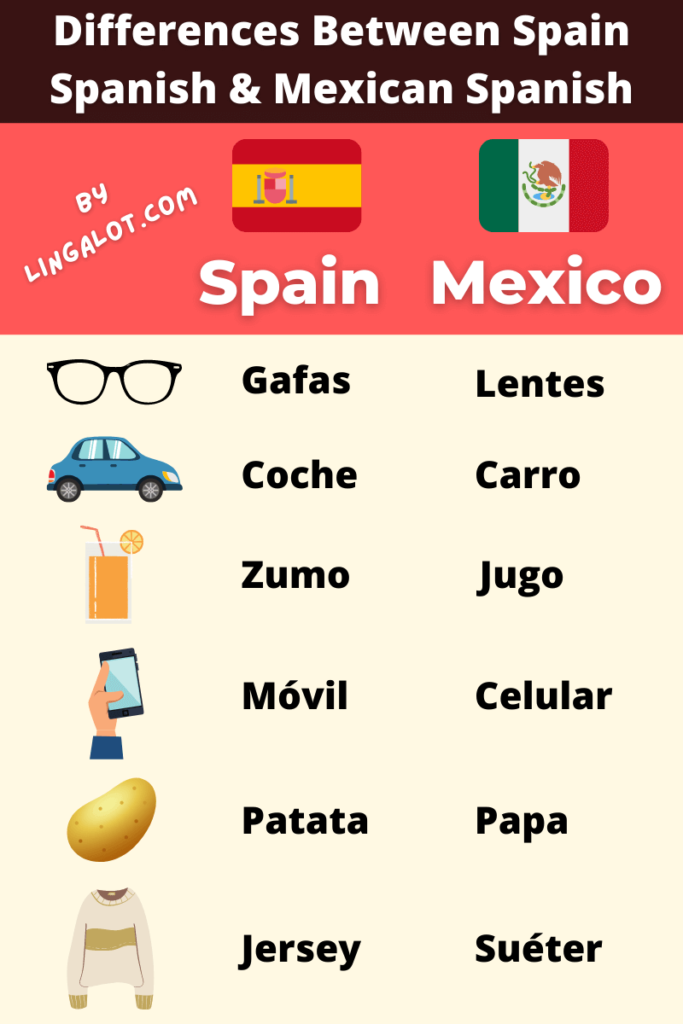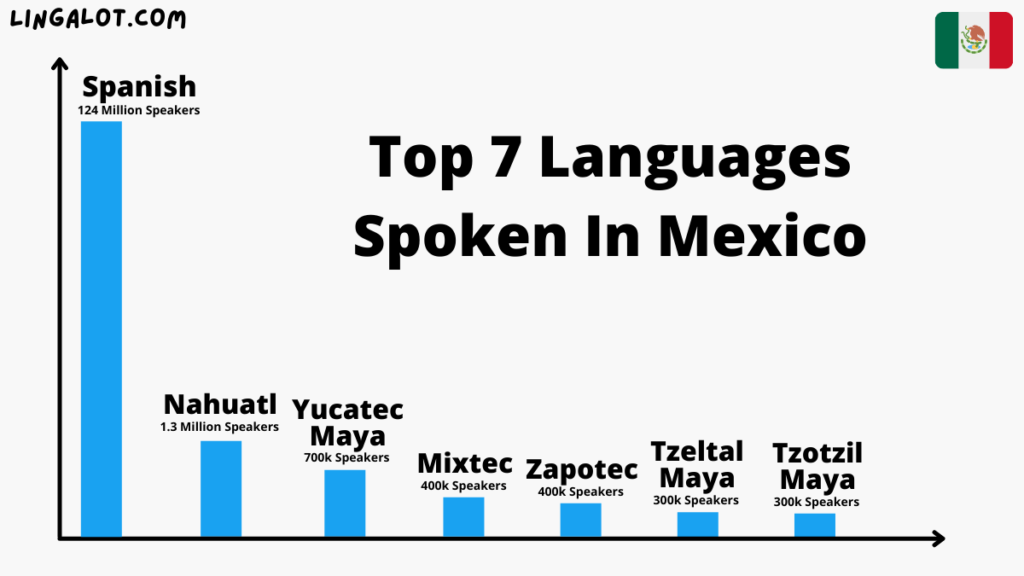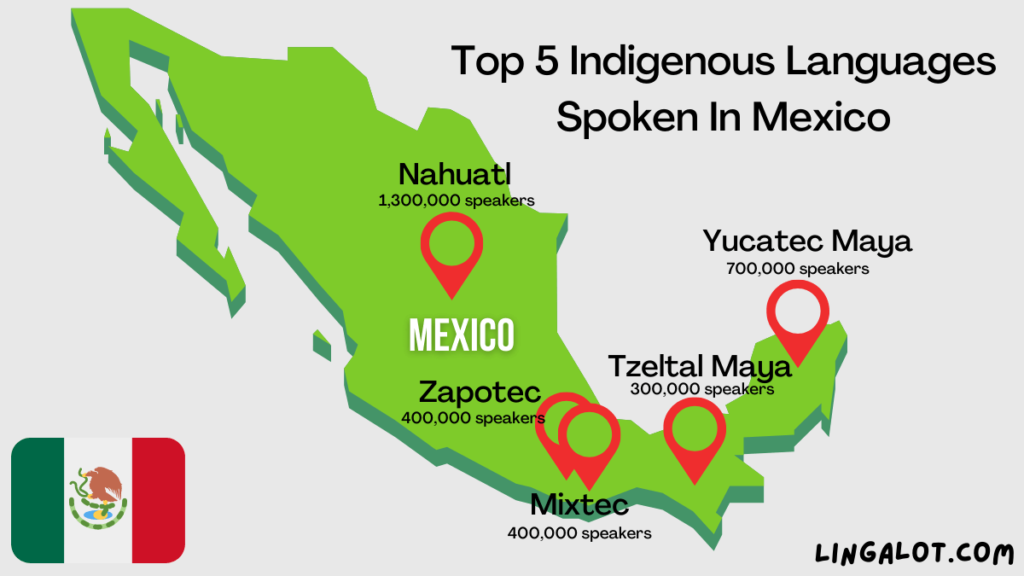You may be wondering what languages do they speak in Mexico? Is Mexican a language?
The answer to that would be no, Mexican is not a language but they do speak a distinct version of Spanish that has been influenced by Mexican culture and history over the years.
As well as Spanish, 7 million people in Mexico actually speak an indigenous language (more on this later).
Table of Contents
Do Mexicans Speak Spanish?
Yes, the majority of Mexican people speak Spanish as Spanish is the main language used in Mexico.
Spanish is used almost exclusively in government and all official capacities and is widely spoken in day-to-day life by most people in Mexico.
Even though Mexicans speak Spanish, it is a bit different to the Spanish that is spoken in Spain and other Spanish-speaking countries. In Mexico, they speak Spanish with a Mexican twist.
First, let’s find out whether these differences are enough to make ‘Mexican’ it’s own language.
Is Mexican a Language or Dialect?
A language is a structured form of communication whereas a dialect is just a regional version of a language.
Mexican Spanish is a distinct version of Spanish that has several differences to European Spanish but does it constitute a whole different language?
The answer is no, Mexican Spanish isn’t a language but it is a Spanish dialect. This means that the differences are small and someone from Spain could easily understand someone from Mexico if they happened to bump into each other.
Most of the differences between them are slight variations in pronunciation of some letters and some differing vocabulary words.
A good comparison is American English and British English. These are clearly the same language as Americans and Brits can easily understand each other, however there are small differences in vocabulary and pronunciation.
For example, a British person might use the word ‘trainers’ to describe their shoes but it would be easy for an American to work out they mean ‘sneakers’ from context.
Additionally, if an American were to arrive in the UK they would have no difficulty in understanding the language as the differences are so minor. It’s the same with Mexican Spanish and Spain Spanish.
Native Language Influence on Mexican Spanish
Before the Spanish conquest of Mexico in 1521, believe it or not, nobody in Mexico spoke Spanish.
The Mexicans had their own native languages which were largely lost due to Spanish influence although 7 million people still speak these indigenous languages in Mexico today.
The Mexican Spanish that people speak today was shaped by the dozens of indigenous languages spoken all over Mexico.
In particular, the languages of the Aztec and Mayan peoples were the most widely spoken and these had the most influence on the Spanish spoken in Mexico today.
After the Spanish conquest of Mexico, it took a while for Spanish speakers to outnumber the native language speakers so for some time, the Spanish and native indigenous languages mixed.
This resulted in a new version of Spanish, called Mexican Spanish, which was largely the same as European Spanish but with some native vocabulary and grammar.
This occurred all over Mexico but especially in the capital, Mexico City. When the Spanish conquered Mexico, they built their new capital ‘Mexico City’ on the site of Tenochtitlan, the old capital of the Aztec Empire.
This region was still home to many Aztec people who spoke their own language and they continued to live there and in the surrounding region, initially outnumbering the Spanish speakers.
During this time, a significant number of words from their indigenous language was incorporated into the Spanish language.
The largest indigenous language still spoken in Mexico is the language of the Aztecs, Nahuatl.
The Aztec language of Nahuatl not only influenced Mexican Spanish but all varieties of Spanish spoken across the globe. Below I’ve listed some words which have Aztec origin.
- Chocolate – this word which is the same in both Spanish and English should be familiar to you. The word ‘chocolate’ came from the Nahuatl word ‘xocolātl’ so you can thank the Aztecs for that one.
- Aguacate – this word, which means ‘avocado’ in English, is used by Spanish speakers all over the word. It also has Aztec origin and comes from the Nahuatl word ‘ahuacatl’.
- Cacahuate – this word, which means ‘peanut’ in English, is also used by Spanish speakers all over the word. It came from the Nahuatl word ‘cacahuatl’.
- Tomate – this word means ‘tomato’ in English and came from the Nahuatl word ‘tomatl’.
When the Spanish arrived in Mexico they’d never seen a tomato before so decided to use the indigenous name (they changed the ending to ‘e’ because they couldn’t pronounce the ‘-tl’ ending). This name then was adopted into the English language too.
Whilst the above words have been adopted into the Spanish language spoken in all Spanish-speaking countries, there are even more words of Aztec origin that are just used in Mexico.
- Guajolote – this word means ‘turkey’ and came from the Nahuatl word ‘huaxōlōtl’.
- Papalote – this word means ‘kite’ and came from the Nahuatl word ‘pāpālōtl’ which means ‘butterfly’.
The above words are only used in Mexico and not other Spanish-speaking countries.
How Mexican Spanish Differs From Spain Spanish
Mexican Spanish differs slightly from European Spanish in both pronunciation and vocabulary.
Below we’ve summarized the main differences between Mexican Spanish and European Spanish.
- ‘Vosotros’ isn’t used in Mexico.
In Spain, ‘vosotros’ is used to informally address a group of people. In Mexico, ‘vosotros’ isn’t used and ‘ustedes’ is heard in its place in both formal and informal situations.
- Mexican Spanish uses suffixes to indicate affection or respect.
For example, you often hear -ito added to the end of a word to show affection e.g. the name ‘Juan’ becomes ‘Juanito’ or ‘abuela’, which means ‘grandmother’ becomes ‘abuelita’.
Vocabulary Differences
There are several words that are commonly used in Spain but not in Mexico. Below I’ve listed the most common ones.

- In Spain, glasses are ‘gafas’ but in Mexico they are ‘lentes’.
- In Spain, a car is ‘coche’ but in Mexico it is more commonly referred to as ‘carro’.
- In Spain, computer is ‘ordenador’ but in Mexico it is ‘computadora’.
- In Spain, peaches are ‘melocotones’ but in Mexico they are ‘duraznos’.
- In Spain, a potato is ‘patata’ but in Mexico it is ‘papa’.
- In Spain, a remote control is ‘mando a distancia’ but in Mexico it is ‘control remoto’.
- In Spain, a pen is ‘bolígrafo’ but in Mexico it is ‘pluma’.
- In Spain, a cell phone is ‘móvil’ but in Mexico it is ‘celular’.
- In Spain, an apartment is ‘piso’ but in Mexico it is ‘apartamento’.
- In Spain, a grapefruit is ‘pomelo’ but in Mexico it is ‘toronja’.
- In Spain, juice is ‘zumo’ but in Mexico it is ‘jugo’.
- In Spain, a straw is ‘pajita’ but in Mexico it is ‘popote’.
- In Spain, the verb ‘to park’ is ‘aparcar’ but in Mexico it is ‘estacionar’.
- In Spain, a refrigerator is a ‘nervera’ but in Mexico it is ‘refrigerador’.
- In Spain, an airplane ticket is ‘billete de avión’ but in Mexico it is ‘boleto de avión’.
- In Spain, a sweater is a ‘jersey’ but in Mexico it is a ‘suéter’.
Pronunciation Differences
Another big difference between European Spanish (spoken in Spain) and Mexican Spanish is pronunciation. The same words are often pronounced differently.
One of the biggest pronunciation differences between the 2 dialects are the letters ‘z’ or ‘c’ when it comes before an ‘i’ or an ‘e’. These letters sound like an ‘s’ in Mexico but like a ‘th’ sound in most of Spain.
For example, the word ‘plaza’ which means ‘square’ would be pronounced as ‘plah-thah’ in Spain but as ‘plah-sah’ in Mexico.
Another example is the word ‘gracias’ (meaning ‘thank you’) which is pronounced as ‘grah-thyahs’ in many parts of Spain. In Mexico, it is pronounced as ‘grah-syahs’.
Additionally, Spanish from Spain tends to sound a bit more guttural compared with Spanish from Mexico. This is mainly due to the Arabic influences on Spain Spanish.
Mexican Spanish also incorporates a lot of slang – keep reading to hear some of the most common Mexican slang words and phrases.
Popular Mexican Words and Phrases
Below I’ve listed some of the most common phrases and expressions that you’ll hear in Mexico.
- Mande! – this word is used when you don’t understand something. It’s like saying ‘what?’ or ‘I beg your pardon?’.
- Güey – this word is used to call a person without saying their name. It’s great for if you’re bad at remembering names.
- Padre – whilst this word literally means ‘father’ in Spanish, it has another meaning in Mexico. ‘Padre’ is used to mean ‘cool’ and can describe something you find cool, attractive or fun e.g. this music is so cool.
- ¿Qué onda? – this phrase used in Mexico means ‘what’s up?’.
- ¡A poco! – this phrase literally means ‘a little’ and is used to indicate surprise. Try it if someone tells you they’ve won the lottery or are moving away.
- Sepa la bola – this phrase literally means ‘the ball knows’ and is used when you’re asked a question that you don’t know the answer to. It’s like saying ‘who knows?’ or ‘I don’t know’.
- Desde luego – this phrase is used to say ‘of course’.
- Tener coco – this phrase means ‘to be smart or clever’. You could use this phrase to say ‘he is so clever!’.
As you can see from the phrases listed above, whilst Mexican isn’t its own language, there are plenty of words and expressions that make Mexican Spanish distinct.
How Many Languages are Spoken in Mexico?

According to the Mexican government, 68 languages are spoken in Mexico.
Even though Spanish is by far the most widely spoken language in Mexico with over 124 million speakers, it isn’t actually the official language of Mexico.
The Mexican Constitution defines the country as multicultural and recognizes the rights of indigenous people to ‘preserve and enrich their languages’ and promotes ‘bilingual and intercultural education’.
For this reason in 2003, the Mexican Congress approved a new law which makes all of the indigenous languages spoken in Mexico national languages. This law states that the indigenous languages ‘have the same validity as Spanish in their territory, location and context’.
This law means that Mexicans can use their native languages when communicating with the government and can even request official documents in that language too.
There are also several prominent foreign languages commonly spoken in Mexico. The largest of these are English, German, Arabic, Chinese and Japanese which are mainly spoken by immigrants or children of immigrants.
Most Common Native Languages Spoken In Mexico

7 million people in Mexico still speak an indigenous language – that’s around 5% of the population. Mexico has a long and rich history with many indigenous tribes that have left a mark on history.
Whilst the 2005 Mexican census found that 5.7% of the population speak both Spanish and an indigenous language they also found that 0.8% of the population only spoke an indigenous language.
That’s 848,000 people that live in Mexico but don’t speak Spanish!
The most well-known of these indigenous tribes are the Aztecs and the Mayans and their history and culture still live on today, for example, one of Mexico’s biggest tourist attractions is the Chichen Itza Mayan ruins. There are also many other smaller tribes living in Mexico.
Although these indigenous languages aren’t as widely spoken today as they were before colonization by the Spanish, they still persist in small numbers.
The Mexican government actually recognises 63 indigenous languages however there are many more.
The most commonly spoken indigenous language in Mexico is Nahuatl, an Aztec language. This language comes from the Uto-Aztecan language family and currently has around 1,300,000 speakers.
The second most spoken indigenous language is Yucatec Maya, a Mayan language with over 700,000 speakers.
Below I’ve listed the top most spoken indigenous languages in Mexico and approximately how many people speak them today.
- Nahuatl – 1,376,026
- Yucatec Maya – 759,000
- Mixtec – 423,216
- Zapotec – 410,901
- Tzeltal Maya – 371,730
- Tzotzil Maya – 329,937
- Otomí – 239,850
- Totonac – 230,930
- Mazatec – 206,559
- Ch’ol – 185,299
- Huastec – 149,532
- Chinantec – 125,706
- Mixe – 115,824
- Mazahua – 111,840
- Purépecha – 105,556
This list is by no means complete as there are 63+ indigenous languages spoken in Mexico but these are the most spoken ones.
Nahuatl
The Nahuatl language, also sometimes referred to as Mexicano, is the most widely spoken native language in Mexico with over 1.3 million speakers.
Nahuatl speakers today mostly reside in central Mexico, however some have emigrated to the United States. The speakers within Mexico are scattered mostly within rural areas in central Mexico and by the coastline.
Nahuatl has been spoken in central Mexico since at least the 7th century. It was the language of the Aztecs who dominated central Mexico until the Spanish colonized the country in the 16th century.
Initially it was just a spoken language. After the Spanish conquest, the Latin alphabet was introduced and Nahuatl also became a written language. In fact, Nahuatl is one of the most studied and best-documented languages in the Americas.
The Nahuatl language that is spoken today in Mexico is not identical to the language that was spoken by the Aztecs. This is mainly due to Spanish influence on the language but it is still largely the same.
Yucatec Maya
Yucatec Maya, often referred to as just Maya, is the second most widely spoken indigenous language in Mexico with over 700,000 speakers today.
This language is most commonly spoken in the Yucatán state of Mexico with a smaller number of speakers also residing in northern Belize. There is also a significant community of Yucatec Maya speakers in San Francisco.
This language was originally spoken by the Mayans and was thought to originate from an ancestral language that was spoken around 5,000 years ago known as Proto-Mayan. It began diverging from Proto-Mayan around 3,500 years ago.
Originally this language even had its own script, the Mayan script, however this fell out of use after the Spanish conquest in the 16th century. It was then replaced by the Latin script.
Thanks for reading this post on the languages spoken in Mexico which answers the question ‘is Mexican a language?’.
Although Mexican isn’t a language itself, it’s clear that the languages spoken in Mexico are distinct and have their own twist.
The culture and history of Mexico has influenced the languages spoken there today including influencing its own dialect of Spanish.
Related Posts:
